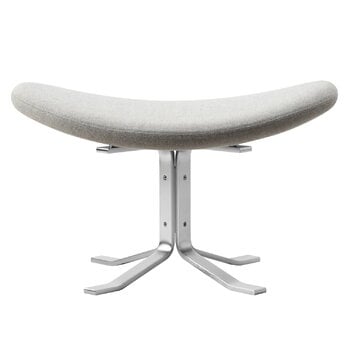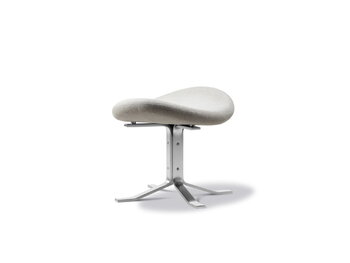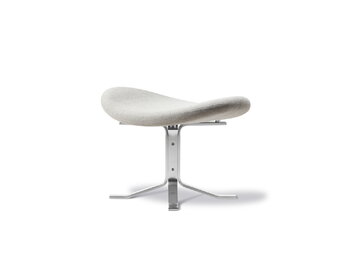Fredericia’s Corona ottoman is a perfect companion for the iconic Corona chair designed by Poul M. Volther in 1964. An extension to the classic, the stylish Corona ottoman lends its elliptical shape from the Corona chair, complementing its design and comfort. The ottoman can also be used separately, as a stool. Perfected with high-quality upholstery, the Corona ottoman is an easy fit for many styles of décor.
Corona ottoman, brushed chrome - Gabriel Capture 4101
Fredericia
Description
Fredericia’s Corona ottoman is a perfect companion for the iconic Corona chair designed by Poul M. Volther in 1964. An extension to the classic, the stylish Corona ottoman lends its elliptical shape from the Corona chair, complementing its design and comfort. The ottoman can also be used separately, as a stool. Perfected with high-quality upholstery, the Corona ottoman is an easy fit for many styles of décor.
Product details (15)
- Colour
- Light grey, chrome
- Width
- 75 cm
- Depth
- 49 cm
- Height
- 47 cm
- Frame material
- Spring steel
- Seat cushion
- Moulded cold cured foam
- Upholstery fabric
- Gabriel Capture 4101: 85% New Zealand wool, 15% polyamide (EU Ecolabel)
- Abrasion resistance
- 200,000 Martindale
- Pilling
- 4-5
- Lightfastness
- 5-7
- Base material
- Spring steel
- Weight
- 10 kg
- Removable cover
- No
- Care instructions
- Vacuum using a clean upholstery attachment but avoid rubbing the fabric.
- Warranty
- 25 years
- Product ID
Designer
Poul M. Volther (1923-2001) was a Danish designer, who was a member of the FDB cooperative, whose aim was to create affordable furniture for everyday use.
Volther was a trained cabinetmaker and studied later at the Arts and Crafts School in Copenhagen. As a believer in functionalism, he avoided short-lived aesthetic styles and concentrated on simple manufacture of fine materials. His best known work is the Corona chair he designed in 1961. Still today around 3000 Corona chairs are sold annually.
View all productsReviews (0)
Sustainability
The Product Sustainability Framework, our criteria of sustainable design, helps you find the most sustainable products in our selection. Read below which sustainability criteria this product has met.
Working conditions & labour 7/9
-
Equal opportunities for all employees
-
Commitment to UN Global Compact, fair compensation for all employees
-
Corporate responsibility requirements defined and communicated for suppliers
-
Systematic work for improved inclusion and well-being in the workplace
-
Transparent supply chain
-
Suppliers' compliance to a code of conduct ensured
-
Support for community involvement in the supply chain
-
Direct suppliers audited and certified
-
Compliance to the UN Guiding Principles on Business and Human Rights ensured in the supply chain
Eco-friendly production 6/9
-
Fair and resource-wise water-use in production
-
No incineration or landfilling of returned items
-
No use of endangered species as materials
-
No direct environmental emissions or waste (excl. GHGs) from production
-
Material-efficient and ecological packaging
-
No potentially harmful chemicals used in own production
-
The sustainability of direct suppliers' production is addressed and monitored
-
Production and material sourcing that respect biodiversity, animal rights, and natural ecosystems
-
Positive impact on nature’s well-being through operations that regenerate natural ecosystems
Climate impact 5/8
-
Company's direct greenhouse gas emissions identified and commitment to reduction
-
Product's carbon impact identified and commitment to reduction
-
Guidance on energy- and eco-efficient use of the product
-
Contribution to climate initiatives beyond the brand’s direct operations
-
Carbon footprint of the product calculated and goals set to reduce it
-
Low-carbon or compensated transportation
-
100 % renewable energy in own production and operations
-
Carbon neutral or carbon negative product
Sustainable materials 5/6
-
Sustainable and long-lasting material choices
-
No harmful or hazardous substances
-
Responsible raw material sourcing and production
-
Materials suited for circularity: monomaterials, recyclable finishings, renewable or recycled contents etc.
-
Ecological materials: natural, biodegradable, recyclable or recycled contents
-
Outstanding materials in terms of innovativeness, responsibility, sustainability and circularity: local production or sourcing, 100 % recycled content, C2C-certification etc.
Circular design 4/5
-
High aesthetic quality promoting long-term use of the product
-
Technically durable product design and material choices
-
Design for enduring life-long quality
-
Design and support for product maintenance, repair and upgradability
-
Innovative circular design solutions: circular service system, resale platform, remanufacturing, collection of used products, etc.









